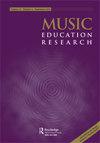The development and characteristics of Korean children’s invented notation for musical representation
IF 1.1
3区 教育学
Q2 EDUCATION & EDUCATIONAL RESEARCH
引用次数: 0
Abstract
ABSTRACT The purpose of this study was to examine the development and characteristics of invented notation for musical representation. A total of 168 young children aged 3, 4 and 5 years participated in this study. The children listened to rhythm and melody, which represented music, to reveal their use of invented notation. The Korean children used various types of invented notation involving figures, numbers, Hangeul (Korean letters), lines, and mixed forms. The level of invented notation increased with age, similar to other kinds of representation competence. The level of invented notation was clearly and significantly higher when paper and drawing tools were used than when blocks were used. However, there was no significant difference in invented notation according to the type of music played (voice or instrument). This study suggests that providing children with various examples of musical experiences and representations as well as tools allows them to perform free and immediate representation without requiring dual representation. Additionally, the findings confirmed that Hangeul has an advantage in children’s musical representation.韩国儿童音乐表现记谱法的发展及其特点
摘要:本研究的目的是考察发明记谱法在音乐表现中的发展和特点。共有168名3岁、4岁和5岁的幼儿参与了本研究。孩子们听着代表音乐的节奏和旋律,以揭示他们对发明的记谱法的使用。韩国的孩子们使用了各种各样的发明符号,包括数字、数字、韩文、线条和混合形式。发明符号的水平随着年龄的增长而增加,类似于其他类型的表示能力。当使用纸和绘图工具时,发明的符号水平明显高于使用木块时。然而,根据演奏的音乐类型(声音或乐器),发明的记谱没有显着差异。本研究表明,为儿童提供各种音乐体验和表现的例子以及工具,可以使他们在不需要双重表现的情况下进行自由和即时的表现。此外,调查结果还证实,韩文在儿童音乐表现方面具有优势。
本文章由计算机程序翻译,如有差异,请以英文原文为准。
求助全文
约1分钟内获得全文
求助全文

 求助内容:
求助内容: 应助结果提醒方式:
应助结果提醒方式:


